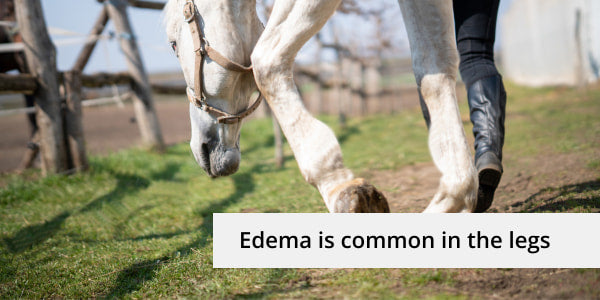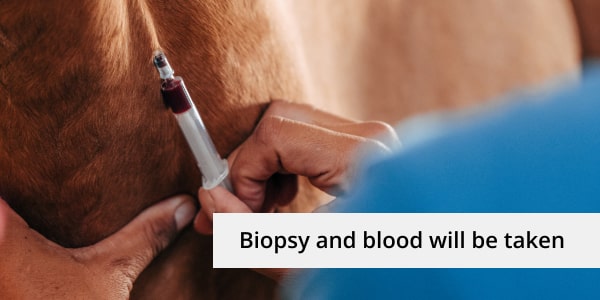In this article we look at Edema (or Oedema) a condition commonly seen within the equestrian community. We look to understand the causes, diagnosis techniques used and commonly applied treatments. A valuable article containing information to help you support a horse with Edema inflammation.
Treating Edema (or Oedema) in horses - a form of inflammation - is a critical aspect of equine care and a common condition within the equestrian community.
Many horse owners will have experienced a horse with Edema; often arriving at the stable one morning to be horrified by the sight of their horses legs heavily swollen.
Edema is an accumulation of lymphatic fluid under the horses skin that has settled at points within the body, most commonly in the legs but also found in the belly.
Luckily, although Edema swelling can look serious, the fluid build up is not blood or plasma but referred to as ‘interstitial fluid' and is actually the fluid that surrounds the cells of the body and is part of the horses natural recovery process; created by the immune system as a protective mechanism.
Edema can arise from various causes, ranging from minor injuries to serious medical conditions. Understanding the causes, diagnosing accurately, and employing effective treatments are key steps in managing this issue for optimal equine health and performance.
Understanding Horse Edema
Horse Edema refers to the abnormal accumulation of fluid in the horses tissues, leading to swelling - most commonly located in the legs or belly.
In horses, Edema swelling within the legs is a common occurrence due to their weight-bearing nature and athletic activities. It can affect any part of the leg, including the lower limbs and joints and can occur when the horse is stabled or standing around for long periods of time, such as travelling to an event.
On the other hand, inflammation in horses’ legs is the body’s response to an injury, infection, or irritation. It involves the immune system releasing chemicals to protect and repair damaged tissues, often resulting in heat, redness, swelling, and sometimes pain.
As well as in a horses’ legs, Edema can also be found in the lowest part of a horses belly - known as Ventral Edema. Edema should not be mistaken for other lumps and bumps such as Cysts or Abscesses which can be found all over the body, Pressure bumps often found on the back, Serum bumps which are secondary to a direct trauma such as a kick and also Splint injuries or Ringbone which also produce inflammation.
Edema in Horses’ Legs
Edema in a horses legs is more common when the horse is stabled with limited access to pasture or on the road travelling.
Although it may appear worrying, in many cases the swelling will reduce naturally when light movement returns.
Windgalls, sometimes known as Wind puffs, can look similar to Edema as they create swollen effects above and below the fetlock; in fact Windgalls are not a form of Edema as the swelling is caused by a build up of joint fluid on the digital flexor tendon.
In the vast majority of cases, movement stimulates the lymphatic system so try turnout, walking in-hand, light riding or lunging - most of these will show a reduction in the Edema inflammation. In some cases, horse owners can learn specific lymphatic massages which stimulate the lymphatic system.

Equine Ventral Edema
Equine Ventral Edema will normally appear in the middle of your horses belly but can be found anywhere in the belly and is where an accumulation of fluid under the skin has built up. Many describe the swelling as feeling like “bread dough” and in most cases will be a few inches long; in more severe cases the entire abdomen will show a swollen area.
Most Ventral Edema cases will subside over a few days but if symptoms do persist this could indicate an infection or another underlying issue and as such you should immediate medical advice. If let alone complications such as heart failure and kidney or liver disease can occur.

Other Causes of Lumps and Bumps in Horses
Although Edema is common there are other commonly found lumps and bumps which horses can develop.
It’s worth establishing that the lump of bump does not relate to any of the following conditions before diagnosing the bump as Edema. In the majority of cases, consult with your veterinarian.
Teething Bumps (Eurption Cysts) on horses
These are small bumps that are located on a horses jaw bone and will commonly appear on both sides of the jaw, normally in younger horses between two and four years old and are in fact caused by the horses adult teeth pushing the baby teeth out. If the teeth are painful to touch it is advisable to seek veterinary assistance.
Pressure Bumps on horses
These are bumps which appear on the horses back, under the saddle area and are often found where the horses tack is in contact with the horses skin. Pressure bumps are firm and dissimilar to Edema swelling. If you do detect pressure bumps then it’s an indication that the tack being fitted to the horse is the incorrect size.
Splint bumps on horses
Splint bumps in horses can occur both inside and outside of the legs - both on the hind legs and front legs. The small splint bone runs down the side of the horses cannon bone between the knee and the fetlock and if the splint is damaged it can damage the suspensory ligament. Splint injuries can be degenerative and be caused over a period or through a traumatic injury. Splint injuries are more common in sports horses due to the fast-paced nature of their lives. Splint injuries vary in severity but require immediate medical attention.
- Seromac
A Seroma is a fluid-filled sac that occurs after a traumatic event, most commonly following a kick from another horse or a bad fall. They are most commonly found on the side if the chest but can appear anywhere on the body. Seromas are soft to touch and often resemble a water balloon and will often cause little to no discomfort for your horse. - Abscessed Submandibular Lymph Node
The submandibular lymph nodes are small lymph nodes located in the horses jaw bones, on occasions these can become infected and the infection accumulates within the pocket of the lymph - causing small lumps or bumps. As with any type of access, if you detect anything which resembles an access contact your veterinarian immediately. -
Ringbone
Ringbone in a condition found in horses which as the same suggests creates a small ring shape bump around the horses leg. A bump appears on the back or the side of the horses cannon bone and can often signify damage to the horses flexor tendons. As the tendon is injured, torn fibres create bleeding which can then lead to an accumulation of fluid within the damaged tissues. This fluid can lead to a bump; shaped like a ring. In all cases you should consult with your vet.
- Tumours
A tumour is a mass of cancerous cells, which include melanomas and sarcoid tumours. It is impossible to know what the tumour is without a biopsy as tumours can vary in appearance and feel. Consult your vet immediately.
Causes of Edema and Inflammation
There are many causes why a horse can develop Edema, we take a closer look at the most common reasons;
-
Injuries: Traumatic events such as kicks, falls, or over exertion can cause localised Edema and inflammation in the legs.
-
Infections: Bacterial, viral, or fungal infections in the legs, such as cellulitis or lymphangitis, can lead to swelling and inflammation.
-
Poor Circulation: Conditions like venous insufficiency or heart failure can impair blood flow, causing fluid buildup in the legs.
-
Allergies: Some horses may develop allergic reactions to environmental factors like insect bites, leading to swelling and inflammation.
-
Joint Issues: Conditions such as equine arthritis or synovitis can cause inflammation within the joints, resulting in swollen legs.
- Lymphatic System Disorders: Problems with the lymphatic system, responsible for draining fluid from tissues, can result in Edema, especially in the lower limbs.
Diagnosing Edema and Inflammation
Accurate diagnosis is crucial for determining the underlying cause and planning effective treatment strategies. Veterinarians employ various techniques to assess and diagnose Edema and inflammation in horses’ legs:
-
Physical Examination: Visual inspection and palpation of the affected leg(s) to assess swelling, heat, and pain levels.
-
Ultrasonography: Imaging techniques like ultrasound and thermal imaging can help visualise soft tissues, joints, and fluid accumulations in the legs.
-
Blood Tests: Assessing blood parameters can provide insights into possible infections, inflammatory markers, or systemic conditions.
-
Joint Aspiration: In cases of suspected joint inflammation, synovial fluid analysis through joint aspiration helps in diagnosis.
-
Biopsy: In certain chronic or complex cases, a tissue biopsy may be necessary to identify specific underlying conditions.

Commonly Used Treatments for Edema
- Rest and Movement: In many cases, Edema swelling will reduce as the horse begins to walk and move around. Fluid will slowly drain away and the inflammation will subside.
- Ice Therapy: Mild cases of Edema and inflammation often respond well to cold therapy, which helps reduce swelling and pain.
- Advanced Magnetic Therapy: Long term support for a horse with Edema, advanced magnetism such as EQU StreamZ bands provide users with a highly-rated complementary option which creates no heat and targets inflammation fast.
- Compression Bandaging: Applying pressure through bandages or specialised wraps can assist in reducing fluid buildup and supporting affected tissues.
- Anti-Inflammatory Medications: Non-steroidal anti-inflammatory drugs (NSAIDs) such as phenylbutazone (bute) or flunixin meglumine (Banamine) are commonly used to alleviate pain and inflammation.
- Antibiotics and Anti-fungals: In cases of infections contributing to leg issues, targeted antimicrobial or anti-fungal medications are prescribed based on culture and sensitivity tests.
- Joint Injections: For joint-related inflammation like equine arthritis, intra-articular injections of corticosteroids or hyaluronic acid may be recommended to reduce inflammation and improve joint function.
- Lymphatic Massage and Drainage: Manual lymphatic drainage techniques, including Kinesiology, performed by trained professionals can aid in reducing lymphatic congestion and Edema.
- Nutritional Management: Ensuring a balanced diet rich in essential nutrients, particularly antioxidants and omega-3 fatty acids, supports overall health and may reduce inflammation.
- Surgical Interventions: In severe cases such as abscesses, deep infections, or joint pathologies, surgical procedures like drainage, debridement, or corrective surgeries may be necessary.
Preventive Measures for edema swelling in horses
While treating edema and inflammation is crucial, preventive measures play a vital role in maintaining horses’ leg health:
- Proper Conditioning: Gradual training programs and conditioning routines help build muscular strength and endurance, reducing the risk of overuse injuries.
- Regular Monitoring: Periodic veterinary check-ups and soundness evaluations can detect early signs of leg issues, allowing timely interventions.
- Environmental Management: Minimizing exposure to allergens, maintaining clean and dry living conditions, and proper insect control contribute to overall leg health.
- Appropriate Foot Care: Regular hoof trimming and shoeing by skilled farriers promote balanced weight distribution and reduce strain on leg structures.
- Therapeutic Tack Options: Continuous management of your horses ongoing wellbeing is key; with ‘prevention as important as cure’ as a commonly adopted mantra. Many owners now support their horses joints and wellbeing with tack such as Advanced Magnetic horse bands.
- Nutritional Support: Providing a well-balanced diet tailored to individual needs supports overall health, immunity, and tissue repair processes.
Conclusion - Edema in horses
Edema and inflammation in horses’ legs are multifactorial issues that require a comprehensive approach to diagnosis and treatment.
By understanding the underlying causes, implementing appropriate diagnostic methods, and employing effective treatments ranging from conservative management to advanced interventions, horse owners can ensure optimal leg health and performance.
Preventive measures and ongoing monitoring further contribute to long-term wellness, allowing horses to thrive in their respective activities while minimising the impact of leg-related issues.
Consulting with equine veterinarians and healthcare professionals remains paramount in navigating these challenges and ensuring the best outcomes for our beloved equine companions.

